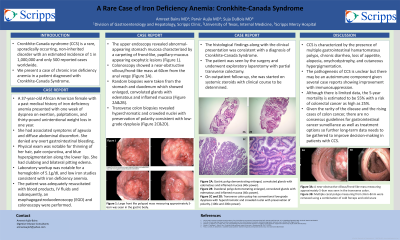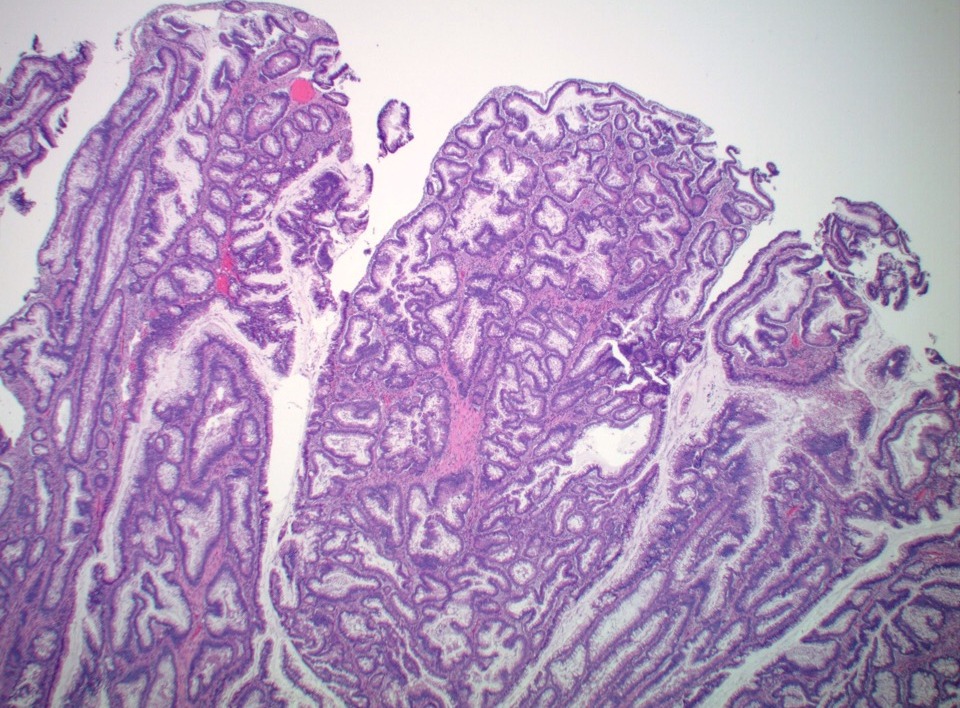Tuesday Poster Session
Category: Colorectal Cancer Prevention
P3216 - A Rare Case of Iron Deficiency Anemia: Cronkhite-Canada Syndrome
Tuesday, October 24, 2023
10:30 AM - 4:00 PM PT
Location: Exhibit Hall

Has Audio

Amreet A. Bains, MD
Scripps Green Hospital
Fresno, CA
Presenting Author(s)
Amreet A. Bains, MD1, Parvir Aujla, MD2, Suja DuBois, MD3
1Scripps Green Hospital, Fresno, CA; 2University of Texas, Houston, TX; 3Scripps Mercy Hospital, San Diego, CA
Introduction: Cronkhite-Canada syndrome (CCS) is a rare, sporadically occurring, non-inherited disorder with an estimated incidence of 1 in 1,000,000 and only 500 reported cases worldwide. We present a case of chronic iron deficiency anemia (IDA) in a patient diagnosed with CCS.
Case Description/Methods: A 37-year-old African American female presented with one week of dyspnea on exertion, palpitations, and thirty-pound unintentional weight loss in one year. She had associated symptoms of ageusia and diffuse abdominal discomfort. She denied any overt gastrointestinal bleeding. Physical exam was notable for thinning of her hair, pale conjunctiva, and blue hyperpigmentation of the lips. She had clubbing and bilateral pitting edema. Laboratory workup was notable for a hemoglobin of 5.1g/dL and low iron studies consistent with IDA. The patient was adequately resuscitated and subsequently, an esophagogastroduodenoscopy (EGD) and colonoscopy were performed. The upper endoscopy revealed abnormal-appearing stomach mucosa characterized by a carpeting of frond-like, papillary-mucous appearing exophytic lesions. Colonoscopy showed a near-obstructive villous/frond-like mass at 60cm from the anal verge. Random biopsies were taken from the stomach and duodenum which showed enlarged, convoluted glands with edematous and inflamed mucosa. Transverse colon biopsies revealed hyperchromatic and crowded nuclei with preservation of polarity consistent with low-grade dysplasia. The histological findings along with the clinical presentation was consistent with a diagnosis of CCS. The patient was seen by the surgery and underwent exploratory laparotomy with partial transverse colectomy. On outpatient follow-up, she was started on systemic steroids with clinical course to be determined.
Discussion: CCS is characterized by the presence of multiple gastrointestinal hamartomatous polyps, chronic diarrhea, loss of appetite, alopecia, onychodystrophy, and cutaneous hyperpigmentation. The pathogenesis of CCS is unclear but there may be an autoimmune component given several case reports showing improvement with immunosuppression. Although there is limited data, the 5-year mortality is estimated to be 55% with a risk of colorectal cancer as high as 25%. Given the rarity of the disease and the rising cases of colon cancer, there are no consensus guidelines for gastrointestinal cancer surveillance as well as treatment options so further long-term data needs to be gathered to improve decision-making in patients with CCS.

Disclosures:
Amreet A. Bains, MD1, Parvir Aujla, MD2, Suja DuBois, MD3. P3216 - A Rare Case of Iron Deficiency Anemia: Cronkhite-Canada Syndrome, ACG 2023 Annual Scientific Meeting Abstracts. Vancouver, BC, Canada: American College of Gastroenterology.
1Scripps Green Hospital, Fresno, CA; 2University of Texas, Houston, TX; 3Scripps Mercy Hospital, San Diego, CA
Introduction: Cronkhite-Canada syndrome (CCS) is a rare, sporadically occurring, non-inherited disorder with an estimated incidence of 1 in 1,000,000 and only 500 reported cases worldwide. We present a case of chronic iron deficiency anemia (IDA) in a patient diagnosed with CCS.
Case Description/Methods: A 37-year-old African American female presented with one week of dyspnea on exertion, palpitations, and thirty-pound unintentional weight loss in one year. She had associated symptoms of ageusia and diffuse abdominal discomfort. She denied any overt gastrointestinal bleeding. Physical exam was notable for thinning of her hair, pale conjunctiva, and blue hyperpigmentation of the lips. She had clubbing and bilateral pitting edema. Laboratory workup was notable for a hemoglobin of 5.1g/dL and low iron studies consistent with IDA. The patient was adequately resuscitated and subsequently, an esophagogastroduodenoscopy (EGD) and colonoscopy were performed. The upper endoscopy revealed abnormal-appearing stomach mucosa characterized by a carpeting of frond-like, papillary-mucous appearing exophytic lesions. Colonoscopy showed a near-obstructive villous/frond-like mass at 60cm from the anal verge. Random biopsies were taken from the stomach and duodenum which showed enlarged, convoluted glands with edematous and inflamed mucosa. Transverse colon biopsies revealed hyperchromatic and crowded nuclei with preservation of polarity consistent with low-grade dysplasia. The histological findings along with the clinical presentation was consistent with a diagnosis of CCS. The patient was seen by the surgery and underwent exploratory laparotomy with partial transverse colectomy. On outpatient follow-up, she was started on systemic steroids with clinical course to be determined.
Discussion: CCS is characterized by the presence of multiple gastrointestinal hamartomatous polyps, chronic diarrhea, loss of appetite, alopecia, onychodystrophy, and cutaneous hyperpigmentation. The pathogenesis of CCS is unclear but there may be an autoimmune component given several case reports showing improvement with immunosuppression. Although there is limited data, the 5-year mortality is estimated to be 55% with a risk of colorectal cancer as high as 25%. Given the rarity of the disease and the rising cases of colon cancer, there are no consensus guidelines for gastrointestinal cancer surveillance as well as treatment options so further long-term data needs to be gathered to improve decision-making in patients with CCS.

Figure: 20X view of the transverse colon polyp: enlarged, convoluted glands within edematous and inflamed mucosa. The polyp also has conventional low-grade dysplasia with hyperchromatic and crowded nuclei with preservation of polarity
Disclosures:
Amreet Bains indicated no relevant financial relationships.
Parvir Aujla indicated no relevant financial relationships.
Suja DuBois indicated no relevant financial relationships.
Amreet A. Bains, MD1, Parvir Aujla, MD2, Suja DuBois, MD3. P3216 - A Rare Case of Iron Deficiency Anemia: Cronkhite-Canada Syndrome, ACG 2023 Annual Scientific Meeting Abstracts. Vancouver, BC, Canada: American College of Gastroenterology.
